|
|
|
|

KAPPA = River Imp, Water Sprite
Origin = Japan (with Chinese & Hindu Antecedents)
Kappa 河童 (river child), or Kawatarō 河太郎 (river boy) or Kawako 河伯 (river earl),
or Kawako 河子 (river child), or Kawaranbe 河ランベ, or Gatarō がたろう or Enkō 猿猴.
One of Many Japanese Suijin 水神 (Water Kami, Water Deity, Water Spirit, Water Fairy)
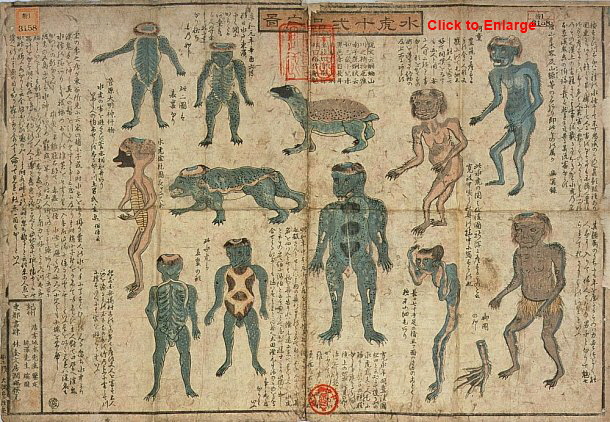
Kappa drawings from mid-19th century Suiko juni-hin no zu 水虎十二品之図 (Illustrated Guide to 12 Types of Kappa).
Source: National Diet Library (Tokyo). Based on the earlier (1820 & 1839) Suikokōryaku 水虎考略 (Concerning Kappa),
attributed to Koga Tōan 古賀侗庵 (1788-1847) and illustrated by artist Kurimoto Tanshu 栗本丹洲 (1756-1834).
KAPPA 河童 and SUIJIN 水神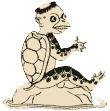 The Kappa is o ne of many Suijin 水神 (water kami, water deities) in Japanese mythology. Suijin are supernatural beings found in lakes, ponds, springs, wells, and irrigation waterways. They are often depicted as a snake, a dragon, an eel, a fish, a turtle, or a kappa. Many trace their origins back to earlier Chinese mythology, although Japan’s Kappa lore is largely indigenous. The Suijin commonly possess magical powers, which can be used for either benevolent or malevolent purposes. For instance, the flesh-eating Kappa is mostly evil, but when captured, it will pledge to assist with farm work or to teach its captor the arts of setting bones and making medicines and salves. One of the most curious Suijin in Japan manifests itself as the water-cleansing bacteria in sewage water (see Gabi Greve for details
References: Dr. Gabi Greve
One of the most curious forms of Suijin is said to manifest itself inside sewage water. The below story comes from site contributor Dr. Gabi Greve, a long-time resident of Japan: "When we remodeled our old Japanese farmhouse, we had to do something about the old toilet. It was just a small pond in the ground, with two beams over it where you had to balance real hard while performing your job. Below you was the open sewer. The local carpenter decided to drain the sewage water, fill the hole up with earth, and level it with the rest of the ground. But before doing anything, we were informed, we had to pacify the Suijin-sama living in the bog. With rice wine (Japanese sake) and purifying salt and a lot of mumbling prayers, the deity was informed that s/he was to be relocated to the wet rice paddies further down the hill. After the water was drained, a pipe was stuck in the hole before it was filled up, so that Suijin-sama, who might have been trapped inside, could find a way out." Gabi-san also discovered a web site (no long online) claiming that this toilet-water Suijin takes the form of good bacteria -- bacteria that cleanses the water for reuse in the soil.
Also see Gabi's SUIJIN God of Water page. ). According to the Institute for Japanese Culture & Classics (Kokugakuin University) , women have played an important role in the history of Suijin worship in Japan. However, with the great influx of Korean and Chinese people into Japan starting around the 2nd century AD, and with the subsequent introduction of Buddhism in the 6th century, Japan’s many indigenous water kami began to slowly absorb attributes from these emigrants and from Buddhism. Not surprisingly, this ongoing mixture of traditions makes it difficult to identify the origins of these “syncretic” deities. This difficulty is compounded by the lack of Shintō artwork or written records prior to the 8th century. The most powerful, universal, and benevolent Suijin in Japan is known as Mizu no Kamisama 水の神様 (Goddess/God of Water). The Kappa, however, is more accurately described as the Kawa no Kami 川の神 (River Deity), a term mentioned in the Nihon Shoki 日本書紀 (Chronicles of Japan), one of Japan's earliest official records, compiled around 720 AD. Some believe the Kappa, who didn’t appear as a popular icon until much later in the Edo Period (1615-1868), is none other than the river deity Kawa no Kami . Please see the Suijin Page for details on Japan’s Suijin traditions.
|
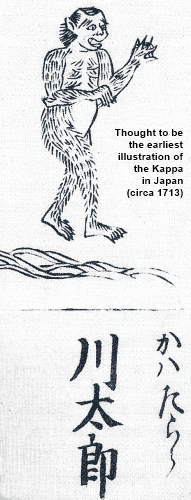
Kawatarō (aka Kappa)
Appeared in the Wakan Sansaizue,
和漢三才図会, circa 1713, a 105-volume encyclopedia complied by Terajima Ryōuan 寺島良安.
This drawing is considered to be
Japan’s earliest illustration of a kappa.
Image courtesy of the East Asia
Library, Stanford University
|
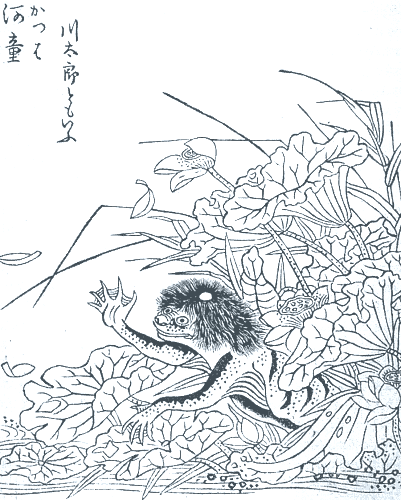
Kappa in the Gazu Hyakkiyagyō 画図百鬼夜行.
Drawing by Toriyama Sekien 鳥山石燕.
Published in 1776, the Gazu Hyakkiyagyō is a four-volume set
with illustrations of more than two hundred different yōkai 妖怪 (monsters).
Above illustration courtesy of Kawasaki City Museum.
Above two photos were scanned from the English book entitled
Pandemonium and Parade: Japanese Monsters and the Culture of Yōkai,
by Michael Dylan Foster. English. ISBN-10: 0520253620. Published Nov. 2008.
|
|
|
|
|
Image by PANIC
Modern Drawing
Retrieved from web Oct. 2002
Site now defunct.
|
|
KAPPA LORE. Kappa are Japanese flesh-eating water imps who live in rivers, lakes, ponds, and other watery realms. They smell like fish and are generally portrayed with the body of a tortoise, ape-like head, scaly limbs, long hair circling the skull, webbed feet and hands, and yellow-green skin. They are often depicted with a tortoise shell attached to their backs. Some say they can change color like the chameleon. They abhor metal objects and loud noises (cannon fire, gunfire, etc.). The defining characteristic of the Kappa is the hollow cavity atop its head. This saucer-like depression holds a strength-giving fluid. Should you chance upon the quarrelsome Kappa, please remember to bow deeply. If the courteous Kappa bows in return, it will spill its strength-giving water, making it feeble, and forcing it to return to its water kingdom. About the size of a child aged 6 to 10, the Kappa is nonetheless incredibly strong. It attacks horses, cattle, and humans, usually dragging its prey into the water, where, according to various legends, it feeds on their blood, or drains their life force, or pulls out their livers through their anuses, or sucks out their entrails, leaving nothing behind except a hollow gourd. In some tales, the Kappa is associated with theft and raping women. Stories tell of Kappa pulling little children into the water and drowning them. In many localities, drowning is still referred to as GAPPADOKO ガーッパドコ (e.g., near Nagasaki in Iwate Prefecture). SHIRIKODAMA. As drowning victims are generally found with a distended anus (swollen rectal), the Kappa is also sometimes called the shirikodama 尻子玉 (lit. = anus ball, also written 尻小玉) vampire. The shirikodama is a mythical ball at the mouth of the anus. In order for the Kappa to steal the liver of the victim (by reaching its arm up into the victim’s anus or shiri 尻), the Kappa must first suck out or remove the shirikodama, which means certain death for its former owner. The belief in this ball is rather mysterious, and scholars have come up with various explanations. One explanation is the commonly observed “open anus” of drowning victims (as if something had been removed or sucked out). Another conceivable reason could be the Tanden 丹田, or "elixir field," which is located beneath the navel and represents the focal energy point in age-old yogic breathing and meditative techniques. Some Japanese scholars
(Ando / Seino 1993)
References: Ando Misao and Seino Fumio, 1993, Kappa no Keifu (The Lineage of the Kappa), Tokyo: Satsuki Shobo. Purchase this J-book online.
The horse and the dragon in both China and Japan are considered manifestations of the water-spirit. The belief that water-gods or water-spirits appear in the form of dragons, who breed with mares and sire legendary horses, is widespread in Asia. In Japan, the Kappa pays homage to the water-spirit by offering the shirikodama or liver of its victims.
Says Ishida Eiichiro in The Kappa Legend, Folklore Studies, Vol. X, 1950: "The legend of the kappa trying to lure horses into the water, and the idea of setting up pastures by the waterside so that dragons or water-gods might breed with mares, and the superstition that famous horses have appeared either out of the water, or some place near the water, may all be considered to have some connection with each other, and to form a part of a common folklore, and it is quite possible to suppose that they all spring from some common origin." say the Kappa offers the shirikodama and/or liver as tribute to a snake-shaped dragon deity (the lord of water, the most powerful of all water deities). But, in my mind, the most probable explanation relates to the term tama 玉 (also read dama), which can mean either ball or jewel. When read as “jewel,” it could easily mean life force, spirit, or soul. In paintings (see drawing by Jippensha below), the shirikodama is sometimes portrayed as a jewel with a pointed top -- one that looks exactly like the Hōju 宝珠 (Skt. = Cintamani), the sacred all-powerful wish-granting jewel of Buddhist lore.
|
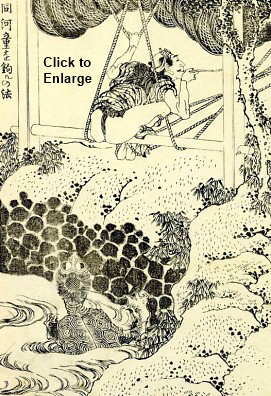
Kappa by Katsushika Hokusai 葛飾北斎 (1760 to 1849)
Entitled: Onajiku kappa-wo tsuru no hō 同河童を釣るの法. Translation: How to Fish (Catch) for Kappa.
Writes scholar Evgeny Steiner (SOAS): “A humorous drawing, which shows one method for attracting and capturing the Kappa -- namely, by showing one’s naked derriere, which the kappa is keen to suck, for inside
the anus is said to be the mythical ball called the
Shirikodama 尻子玉 (literally "buttocks ball"). As soon as
the Kappa draws close, the man drops the net on him.
A dangerous sport!” <end quote>
Photo = #19, Courtesy this J-Site
|
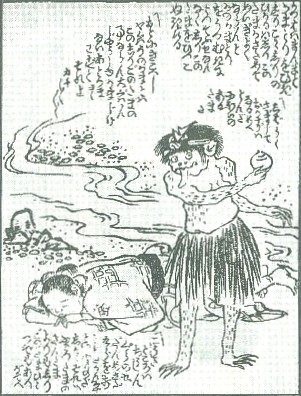
Kappa holding Shirikodama (1797)
Drawing by Jippensha Ikku 十返舎一九 (1765 to 1831). Jippensha was a popular Edo-period artist and writer of
Kibyōshi 黄表紙 (yellow-backed novels), a type of
illustrated picture book. Here we see the Kappa holding the
shirikodama in his right hand, with his victim lying dead on
the ground. The shirikodama in this drawing looks
exactly like the Buddhist wish-granting jewel.
Photo: Union Catalogue of Early Japanese Books
日本古典籍総合目録 (1797); National Institute of Japanese Literature Digital Library 国文学研究資料館電子資料館.
|
|
SHIRI 尻 (BUTTOCKS), TOILETS, & WOMENSays scholar
Michael Dylan Foster:
References: Foster, Michael Dylan. The Metamorphosis of the Kappa: Transformation of Folklore to Folklorism in Japan. Asian Folklore Studies, Vol. 56, 1998. Also see Pandemonium and Parade: Japanese Monsters and the Culture of Yokai, by Michael Dylan Foster. English. ISBN-10: 0520253620. Published Nov. 2008. “The kappa's obsession with the shiri (buttocks, hips) is made apparent in legends that describe the kappa hiding in the toilet, waiting to stroke or fondle a female victim's shiri............
Orikuchi
References: Orikuchi Shinobu. Kappa no Hanashi (A Discussion of Kappa). In Orikuchi Shinobu Zenshu (Collected Writings of Orikuchi Shinobu), Vol. 3, pp. 288-317. Tokyo: Chuo Koronsha. 1955. points out that, in the past, toilets were often situated above rivers; more important, however, is his suggestion that if we go back to an early legend of a kappa transforming itself into a red lacquered arrow and entering the ’shy place’ of a woman, we can see that the kappa's objective in hiding in the toilet is not necessarily to take the shirikodama (Orikuchi
References: Orikuchi Shinobu. Kappa no Hanashi (A Discussion of Kappa). In Orikuchi Shinobu Zenshu (Collected Writings of Orikuchi Shinobu), Vol. 3, pp. 292-293. Tokyo: Chuo Koronsha. 1955. ). Indeed, stories of kappa raping women are common.”
Yanagita
References: Yanagida Kunio (1875 - 1962). Yanagida is the famous anthropologist who did the initial research on the Kappa and other supernatural beings in the Tono region (modern-day Iwate Prefecture). He is considered by some to be the father of Japanese folklore study, and the author of the classic Tono Monogatari (Legends of Tono), published 1910. , for example, reports:
In a household beside the river in Matsuzaki village women have become pregnant with kappas' children for up to two generations. When they are born, these children are hacked to pieces, put into small wine casts, and buried in the ground. They are grotesque. <1975 translation, p. 41, of The Legends of Tono; translated by Ronald A. Morse. Tokyo: The Japan Foundation>
|
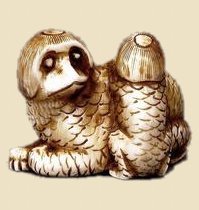
Japanese Ivory Netsuke
Kappa and Kappa Baby
Courtesy of www.2ezr.com

|
|
BONE SETTING SKILLS, MEDICAL SKILLSKappa are mostly evil, but not always. When benevolent, the Kappa is supposedly a skilled teacher in the art of bone setting and other medical skills. In the real world of medicine, the term “kappa” refers to a monoclonal plasma cell related to bone marrow. In addition, the Kappa is always portrayed as trustworthy despite its many evil ways. When captured and forced to promise never again to harm anyone, the kappa always keeps its promise. Kappa often help or mentor those who outwit them or capture them.
Writes scholar
Michael Dylan Foster:
References: Foster, Michael Dylan. The Metamorphosis of the Kappa: Transformation of Folklore to Folklorism in Japan. Asian Folklore Studies, Vol. 56, 1998. : “The kappa is notorious for attempting to lure horses and cows to a watery death; but the key word here is attempting. In most versions of this legend, the kappa fails; its plan backfires and it (or just its arm) is pulled by the startled horse all the way to the stable. The kappa's success rate in fondling women's shiri in the toilet may be slightly higher, but often on its second attempt its arm is grabbed and yanked from the body. And when its mischief goes awry, when it is weakened from losing water from its sara or incapacitated (emasculated) by a yanked-off arm, the honest and benevolent side of the kappa's nature surfaces. In order to be set free or receive back its arm (the arm can often be reattached within a certain number of days), the kappa will take an oath. It will pledge, for instance, to stop harassing people in the area, or to assist with work in the fields, or to teach its captor secret bonesetting techniques and formulas for making medicine and salves. It should be noted that this last trait - the kappa's familiarity with bonesetting and other medical procedures - is one of the most widespread of the beliefs associated with the kappa (see
Ishikawa
References: Ishikawa Jun'ichiro, 1985, pages 217-30. Shinpan Kappa no Sekai (World of the Kappa, new edition]. Tokyo: Jiji Tsushinsha. 1985. Discusses the bonesetting and other medical skills associated with the Kappa. ).” <end quote>
THEORIES ON KAPPA ORIGINS
The Kappa’s origin is difficult to verify precisely. But, by the Edo Period, illustrations of Kappa appear often in anthologies of supernatural tales, in comical paintings (giga), in ukiyo-e (woodblock prints), and in paintings accompanying verse (haiga). In 1910, Kappa lore gained nationwide popularity with the publication of Tono Monogatari (遠野物語; Legends of Tono) by Yanagida Kunio (1875-1962). In Tono Monogatari, Yanagida presented numerous tales of supernatural beings in the Tono area, including stories about the evil Kappa. Today the Kappa is typically depicted as a cute cartoon-like character (see photos below), and appears quite regularly in Japanese fiction, in cartoons for children (Urusei Yatsura, Tenchi Universe), as a cute mascot for commercial products, and in toys.
-
Theory One, Shintō Mythology.
Some believe the Kappa is the “Kawa no Kami” 川の神 (lit. River Deity) mentioned in the Nihon Shoki 日本書紀 (Chronicles of Japan), one of Japan's earliest official records, compiled around 720 AD. Despite the Kappa’s seemingly ancient origin, the creature does not appear (to my knowledge) in texts and artwork of the medieval period. In fact, the earliest illustration of the Kappa comes from the Wakan Sansaizue 和漢三才図会, a 105-volume encyclopedia complied around 1713. Another image appeared in the illustrated four-volume Gazu Hyakkiyagyō 画図百鬼夜行 (Night Procession of One Hundred Demons). See illustrations from both works here. Kappa lore gained steadily in popularity throughout the Edo Period (1615-1868). We find mention of Kawatarō (Kawataro) 河太郎 in a serial called Kasshiyawa 甲子夜話, first appearing in 1821 and running until the death of the author in 1841. We also find mention of the Kappa in the mid-Edo period document named Mimibukuro 耳嚢 (or 耳袋), a 10-volume document written by Negishi Yasumori 根岸鎮衛 (1737-1815). Translated in English as “Bag of Ears,” it is a collection of essays about then-prevailing religious and cultural beliefs. For more historical notes and naming conventions, please click here (outside site, Japanese language).
- Theory Two, Leech Babies.
Some say the term “Kappa” was first applied to leech babies (stillborn infants pitched into the river). "In olden times, poor families often killed newborns because they could not afford to raise them," said an official from Tono City in a Yomiuri Shimbun article. "They generally threw their bodies into rivers. Perhaps adults made up Kappa stories so that children would be afraid to go near the rivers and see the dead babies." For details, please visit www.yomiuri.co.jp/nanjo/. In the 1910 classic book Tono Monogatari (Legends of Tono, 遠野物語), not all Kappa stories end happily. Many of the stories in the book deal with famines and the ill-treatment of stepchildren.
- Theory Three,
Portuguese Monks.
Some say the term “Kappa” originated with the appearance of Portuguese monks in Japan in the 16th century. Clad in cloaks with hoods that hung down their backs like the kappa's tortoise shell, the monk's shaven pate surrounded by a crown of hair also resembled the kappa's hair-rimmed crater of water. Capa, the Portuguese word for the monk's habit, was applied to the sprite and remains in use today. <quote from story by Janet Leigh Foster, Big in Japan, #366, JapanToday.com>
- Theory Four, Chinese Monkeys.
Some say the Kappa descended from monkeys, most notably the writer Yanagida Kunio (1875-1962), the author of Tono Monogatari 遠野物語 (Legends of Tono). Yanagida is considered by most to be the father of Japanese folklore study, so his opinion carries weight. When comparing the different names used by different localities to describe the Kappa (e.g., Kawatarou, Gatarou, Kawako), Yanagida discovered that some areas in Japan refer to the Kappa as Enkō 猿猴 (also spelled Enko), the term for “monkey.” Enkō appears in a famous Buddhist parable from China called Yuanhou Zhuyue (Japanese = Enkō Sokugetsu, 猿猴捉月). In this famous story, a group of monkeys attempt to catch the moon’s reflection, but all are drowned in the effort.
<The Enkō Sokugetsu Story as Quoted by JAANUS>
One night a monkey chieftain saw the bright reflection of the moon in the water below his tree. Thinking that the moon had died and fallen into the water, and fearing that the world would thus slip into darkness, the monkey called together his underlings and commanded them to join tails and together pull the moon out of the water. However, when the monkeys attempted this task, their combined weight was too great, the branch broke, and they fell into the water and drowned. One simple moral of the story is not to recklessly attempt impossible tasks. On a more philosophical level, the image of the monkey attempting to grasp a reflection of the moon is a metaphor for the unenlightened mind deluded by mere appearances. The theme was often depicted in ink painting, usually featuring long-armed spider monkeys. The screen paintings by Shikibu 式部 (16c; Kyoto National Museum) and Hasegawa Touhaku 長谷川等伯 (1539-1610; screen painting at Konchiin 金地院, Kyoto), are representative. <end JAANUS quote>
There are many more indications of the monkey connection. In Tono Town itself, the Sarukaishi River (literally “Monkey Stone River”) flows through the town’s southern section (although I’m not sure when this name was given to the river). In Geishu City, Hiroshima Prefecture, the locals say a monster named Kawazaru 川猿 | かわざる (lit. River Monkey) lives in the waters there, attacking both men and animals. The monster is said to possess the power of 100 men, but its power evaporates if the water atop its saucer-like head is spilled. This Kawazaru story quoted from the Japanese-language site of the International Research Center for Japanese Studies. To learn much more about monkey lore in Japan, click here.
Humorous Ivory Carving
Monkeys, Kappa, Shirikodama and the Moon
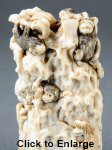 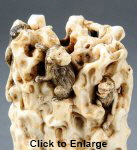 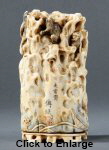
This curious 19th-century ivory carving is most likely from Japan, where it was probably carved by a Chinese artist (as indicated by the artist's signature on the back of the carving -- see third photo above). The telltale signs that this carving came from Japan are the two Kappa (river imps, water sprites) appearing near its base. One holds a shirikodama or anus ball, a mysterious "jewel" sought by the Kappa and said to reside near the mouth of the anus of humans. The removal of the ball means certain death for its former owner. Another Kappa is depicted with outstretched arm, just below the anus of one of the monkeys -- he is clearly trying to extract the shirikodama. Another telltale sign of Japanese origin are the five monkeys. Some Japanese scholars (most noteably Yanagida Kunio, as mentioned above) believe that Kappa descended from monkeys, for in some areas of Japan, the Kappa is referred to as Enkō (the Japanese term for monkey). Enkō appear in the famous Buddhist parable from China called Yuanhou Zhuyue (Japanese = Enkō Sokugetsu). In this famous story, a group of monkeys attempt to catch the moon's reflection, but all are drowned in the effort. In this carving, four of the monkeys are gazing upward at the moon. One monkey has a look of disbelief (as his shirikodama is about to be snatched). This interesting piece incorporates legends from both China and Japan.
- Theory Five, Buddhist Monkey Mythology. Some say the Kappa originated from earlier Buddhist tales from mainland Asia, again tales concerning monkeys. This is actually a sub-theory supporting Theory Four above. Some examples include:
5A. The Monkey King and Water Demon
Among the many tales in the Jataka -- perhaps the oldest extant collection of Buddhist folklore, dating from around the 3rd century BC from India and Sri Lanka -- one story tells of a monkey kingdom confronted by a monkey-eating water demon, and how the wise monkey king outwitted the demon using bamboo. Please click here to read this story, courtesy of buddhanet.net. One site reader made the following comment: “It is possible that Kappa may be distorted form of Kapi which in sanskrit means monkey. There is a kapi-jataka, there is a mention of kapi jembawan (monkey sage) in Indonesian folklore based on kingdom of Dwarka where Lord Krishna ruled, there was also a place called Kapisthali in ancient India (now called Kaithal). Even Tulsidas, a famous Hindi poet who wrote Ramayana about 500 years ago, used the world kapi for Vanaras (monkey race) in South who helped Rama defeat Ravana.”
5B. Journey to the West (西遊記, Japanese = Saiyuuki)
Journey to the West is a famous Chinese story (called Hsi-Yu Chi in Chinese). Although compiled by Wu Cheng'en in the 16th century, the legend existed long before that. It is based on a real person named Xuan Zang (602-664 AD), a Buddhist monk who journeyed to India in search of Buddhist sutras. Protecting him on his journey (in the book) are three companions -- the Monkey, the Pig, and a Water Demon called Sandy (Jp. = Sagojō or Sangojo). To some, the Japanese Kappa is based on Sandy the water demon. According to Chinese mythology, Sagojō was originally the ”Commander of the Heavenly Hosts,“ but he was banished to Earth for accidentally breaking the Jade Emperor’s vase. On earth, he appeared as an ugly water spirit, devouring anyone who strayed near his abode. In Journey to the West, he is armed with a “water staff” with a metal blade on each end, and he wears a necklace of the skulls of his victims.
|
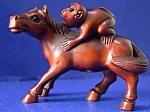
Monkey Riding Horse
Japanese Netsuke
Courtesy rubylane.com
|
|
5C. More Supporting Theories
Monkey “Protector of the Horse”
Another striking overlap between Monkey and Kappa lore is the horse. In Chinese tradition, the monkey is often shown riding the horse. This symbolism too stems from the classic Chinese story Journey to the West (see above), in which the Jade Emperor appoints the Monkey to the post of “Protector of Horses.” See parts of this story here. The horse also appears quite regularly in Kappa mythology. Dozens of stories tell of the Kappa trying to drag a horse into the river, failing, then getting caught by the horse’s owner, and forced to promise to never again harm the horses of the village. In this roundabout fashion, might we not call the Kappa a “guardian deity” of the horse? This topic is briefly explored at this site (J), which also discusses the serial stories called Kappa Heaven, which ran from Showa 28 to Showa 33 in the weekly Asahi Shukan. 実はそれ「清水崑 (シミズ コン)」って漫画家が書いた「かっぱ天国
(昭和28年~33年まで『週刊朝日』にて連載)」の河童なんです。
See Ishida Eiichiro’s “The Kappa Legend” for details on the Kappa’s strong link to horses.
- Theory Six, Ainu Origin. Some say the Kappa is of Ainu origin, but I cannot find any reference in Ainu folklore to support this theory -- although I admit my knowledge of Ainu mythology is woefully lacking. The Ainu, Japan’s earliest inhabitants, live primarily in Hokkaido, the northernmost island, and their folklore is rich in imagery and monsters. Near Sapporo, the main city in Hokkaido, is an area called Jozankei, home to the “Great Kappa King” and the “Kappa Buchi Legend.” However, the Jozankei legends are probably not of Ainu origin. Click here for details on Jozankei. According to the Angelfire web site: “The Ainu believe in a magical connection between trees and humans. For example, when a certain tree is cut down a girl will die. They feel that willows are like living humans and make miniature sacrificial willows from willow peelings (see also Willoughby-Meade, Chinese Ghouls and Goblins for more). The Ainu are also known for their Shamanistic beliefs and practices (perhaps of Siberian origin). To learn more about Ainu myths, please see Ainu Folk Tales by Basil Hall Chamberlain [1888; also the translator of the Kojiki]. The above link provides an online collection of Ainu tales from the book. One story in the collection is called The Old Man of the Sea (Atui Koro Ekashi). It describes an ocean monster able to swallow ships and whales.
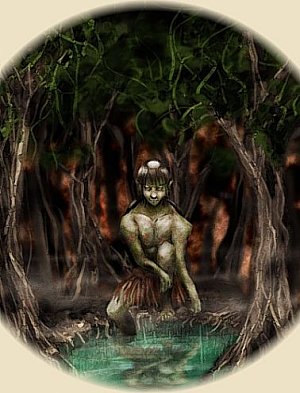
Modern Illustration by Ran 英. Photo from now-defunct web site (last accessed Dec. 2009).
Cover Artwork for Cygnet 11, a modern (now defunct) Japanese science fiction magazine. Published by
Albireo アルビレオ. Albireo is a star in the Cygnus constellation. Cygnet is a play on the word Cygnus.

Metamorphosis of the Kappa in Modern TimesScholar
Michael Dylan Foster
References: Foster, Michael Dylan. The Metamorphosis of the Kappa: Transformation of Folklore to Folklorism in Japan. Asian Folklore Studies, Vol. 56, 1998. Also see Pandemonium and Parade: Japanese Monsters and the Culture of Yokai, by Michael Dylan Foster. English. ISBN-10: 0520253620. Published Nov. 2008. breaks down the modern evolution of the Kappa into three major waves, or "kappa booms." Below text is largely paraphrased from Dyson’s article.
- In the first wave, up until the publication in 1927 of Akutagawa Ryūnosuke's 芥川龍之介 (1892-1927) short novel, Kappa, the kappa image most often interpreted by scholars was the common folkloric conception of the creature, representing ideas that circulated from the Edo period into the early part of the 20th century.
- The second wave came in the 1950s and 1960s when the children who grew up with the images developed by Akutagawa and artist Ogawa Usen 小川芋銭 (1868-1938), who depicted the kappa performing human activities and used kappa imagery as a metaphor for human beings, began to create their own versions. These new images followed in the folklorism tradition of explicitly using the kappa as a metaphor for humans. In the popular urban imagination the kappa had become a friendly and familiar creature of cartoons and statuettes. By the 1960s, a "kappa craze" in the Tokyo area developed, with the appearance of crude and cheap kappa amulets and caricatures of many kinds found everywhere. By the mid-1970s the folklorism version of the kappa - in the guise of cartoon characters and other lighthearted manifestations - had penetrated the countryside.
- In the third phase, the kappa became primarily a commercial icon on both a regional and national scale. The kappa, with its roots in the natural environment and its long history of agricultural involvement, became the perfect symbol for the promotion of the countryside as a domestic tourist destination for the urban dweller seeking "nostalgic confirmation of the cultural landscape."
KAPPA IN THE MODERN JAPANESE LANGUAGE
- Kappa Maki = Cucumber sushi rolls, a common Japanese food. The Kappa love cucumbers according to Japanese legend.
- Okappa = Bobbed hairstyles that look like the Kappa's hair.
- Kappa no Kawa Nagare = Even Kappa can drown. Even a Kappa can get carried away by the river. Kappa are excellent swimmers, so this is a proverb meaning "even an expert can make mistakes." There is a related proverb associated with the Monkey, which goes: Saru mo Ki Kara Ochiru. It means "Even monkies fall from trees."
- Kappa no He = Much ado about nothing (literally “water-imp fart”)
- Kappa = Word for traditional straw raincoat worn by farmers
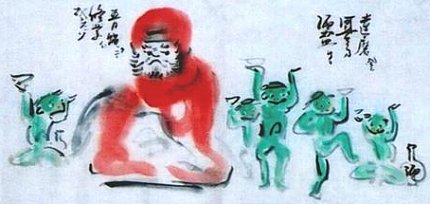
Modern Kappa Painting from Gabi Greve Collection. By Japanese artist Yoshio Yamamoto

COMBAT & SUMOThe chief delight of the mischievous Kappa is to challenge humans to single combat. Indeed, the Kappa delights in Japanese sumo wrestling, and often challenges its victim to a sumo bout. Writes scholar
Michael Dylan Foster:
References: Foster, Michael Dylan. The Metamorphosis of the Kappa: Transformation of Folklore to Folklorism in Japan. Asian Folklore Studies, Vol. 56, 1998. : “In one legend involving sumo, some children are playing by the water when a child with whom they are unacquainted appears and challenges them to sumo. Observing this child closely, they realize it is actually a kappa, and that there is water in the sara on its head. Accordingly, they shake their own heads; the kappa imitates them, spilling the water. Bereft of all strength, it is forced to leave (Ishikawa
References: Ishikawa Jun'ichiro, 1985, pages 217-30. Shinpan Kappa no Sekai (World of the Kappa, new edition]. Tokyo: Jiji Tsushinsha. 1985. 1985, p. 175). This love of the sport of sumo can be found throughout much kappa lore (see e.g.,
Ishikawa
References: Ishikawa Jun'ichiro, 1985, pages 217-30. Shinpan Kappa no Sekai (World of the Kappa, new edition). Tokyo: Jiji Tsushinsha. 1985. 1985, pp. 163-76, and
Iida
References: Iida Michio 1993 Kappa ko: sono yugamerareta shotai wo saguru [Thoughts on kappa: Seeking the true form behind the distortion]. Kyoto: Jinbun Shoin. 1993, pp. 153-60). One common method for defeating the kappa when challenged to sumo, or any other confrontation, is simply to bow politely. The kappa, though mischievous, is essentially a polite creature who defers to human ritual; it will bow in response, spilling its water, and thus losing its power.” <end quote>
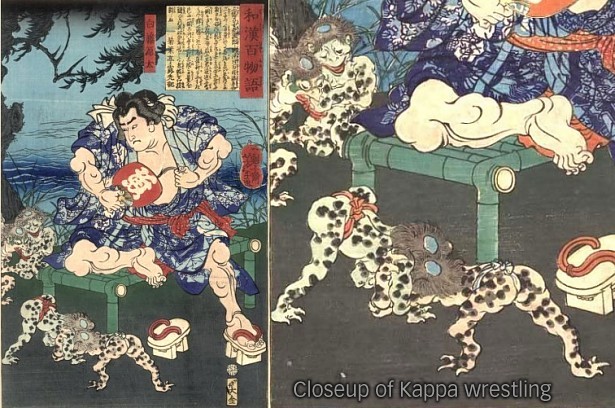
Shirafuji Genta 白藤源太 Watching Kappa Wrestle. Dated 1865.
Woodblock print from Wakan Hyaku Monogatari 和漢百物語 (One Hundred Ghost Tales from China
and Japan). By artist Tsukioka Yoshitoshi 月岡芳年 (1839-1892).
Image 34.9 cm x 22.8 cm, Herbert R. Cole Collection (M.84.31.59),
Japanese Art Department. Image courtesy Los Angeles County Museum of Art (LACMA).
For a well-known kappa legend involving renowned wrestler and strongman Shirafuji Genta, click here.
CUCUMBERS キュウリ
Kappa folk also have a liking for cucumbers, a weakness that can be used to human advantage. According to one tale, an offering of cucumbers (on which are etched the name/age of family members) is enough to appease the Kappa, who thereafter will refrain from harming you and your family (need to give source for this). Even today, cucumber sushi in Japan is called “Kappa-maki”.
Let us quote once again from the wonderful research of scholar
Michael Dylan Foster:
References: Foster, Michael Dylan. The Metamorphosis of the Kappa: Transformation of Folklore to Folklorism in Japan. Asian Folklore Studies, Vol. 56, 1998. “One of the better known of the kappa's traits is its love of kyuri, or cucumbers. Many of the festivals associated with kappa include offerings of cucumbers (e.g.,
Takeda
References: Takeda Akira 1988 Suijinshinko to Kappa (Water deity belief and the kappa). In OSHIMA 1988, 7-16. 1988, p. 12, and
Orikuchi
References: Orikuchi Shinobu. Kappa no Hanashi (A Discussion of Kappa). In Orikuchi Shinobu Zenshu (Collected Writings of Orikuchi Shinobu), Vol. 3, pp. 288-317. Tokyo: Chuo Koronsha. 1955. 1955, pp. 299-300). Here again, the complexity of the kappa belief is apparent. As Takeda points out, there are some regions where it is believed that eating a cucumber and then swimming will lead to certain attack by a kappa, while in other areas it is a way to ensure protection against attack (Takeda
References: Takeda Akira 1988 Suijinshinko to Kappa (Water deity belief and the kappa). In OSHIMA 1988, 7-16. 1988, pp. 11-12). Other foods to which the kappa is partial include nasu (Japanese eggplant), soba (buckwheat noodles), natto (fermented soybeans), and kabocha (pumpkin). <Takeda
References: Takeda Akira 1988 Suijinshinko to Kappa (Water deity belief and the kappa). In OSHIMA 1988, 7-16. 1988, p. 12>. Although the kappa is attracted to some foods of the uri, or melon, grouping - such as kyuri and kabocha - it is clear that it has an aversion to hyotan (gourds), which are also of the melon group. The Nihon shoki passage cited above shows that the power of hyotan to confound the kappa was understood early on. In one of the folktales involving kappa, the so-called kappa muko, or "kappa bridegroom tale" (Ikeda
References: Ikeda Hiroko 1971, pp. 74-75. A type and motif index of Japanese folk-literature. FF Communications 209. Helsinki: Suomalainen Tiedeakatemia. 1971, pp. 74-75), the same motif appears. A farmer, whose fields have dried up because of drought, offers his daughter to anybody who can irrigate them. A kappa succeeds in this task and receives the reluctant bride. The daughter, however, challenges the kappa to sink some gourds in the river. The kappa soon exhausts itself trying to complete this impossible task, and abandons the marriage.” <end quote>
KAWAKO KAPPA 河伯
The Kappa is sometimes called Kawako. The name can be traced to Kawako-no-miya (Shrine of the Kawako), located on the bank of the Kawachi river near Matsue/Izumo. Legend relates that a nasty Kappa was captured near here and forced to sign a note swearing never again to harm any of the people or animals in the area. Unable to write, the Kappa dipped its hand in the ink and pressed it on the document. The document remained among the shrine’s relics, and the Kappa never broke the promise (the Kappa is always portrayed as trustworthy and courteous despite its many evil ways).
KAPPA BRIDGE IN TOKYO
Tokyo's Kappabashi (Kappa bridge) was once farmland surrounded by canals prone to flooding. In the late Edo period a raincoat dealer Kappaya Kihachi devoted his entire personal fortune to building a drainage system. This difficult work took longer than expected and cost a fortune, and he was in despair until a kappa, whose life he had saved years before, suddenly appeared to help. With the kappa's assistance the project was completed in short order. In addition, those who had seen the Kappa were suddenly blessed with good fortune and soon the Kappa Temple was built, and the Kappa enshrined as a deity. <story by Janet Leigh Foster for japantoday.com>.
HOW GENTA SUBDUED A KAPPA
|
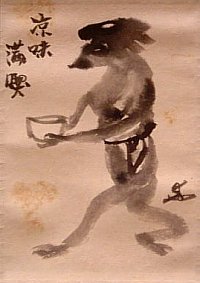
|
|
Drawing of Kappa
by famous 20th-century
Japanese potter named
Kato Tokuro. Click here
for details (outside link).
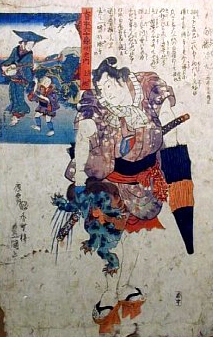
Woodblock Print by
Utagawa Kunisada 歌川国貞 (1786-1864).
Shirafuji Genta, a renowned wrestler, capturing a kappa. For another
image, click here.

|
|
<See below woodblock print.> The following myth has been passed down through the ages in Saga Prefecture. It was translated by Keiko Takada and Eriko Tsudo of Saga Women's Junior College, and appears on the Saga Prefecture site.
Once upon a time in the village of Kawachino there lived a man named Genta. He was from a distinguished family in the village and was so wise and brave that he was greatly respected by the villagers. His house was large and stood near a river which flowed through the village. The river was at its deepest at the bend near his house, and the water looked dark and unfathomable, being over six meters deep.
One summer evening, Genta came back from his outing and told his servants as usual to hitch his horse to a shady tree near the river. After taking a short rest, Genta stepped out into the garden and looked at the tree. To his surprise, a kappa, the size of a 6-7 year old boy was dragging the horse by its hind legs into the river. The silent horse was resisting the pull with its forelegs while strangely enough, the servant as if in a trance, was helping the small kappa by pouring water into the cavity on the kappa's head. The more the servant poured, the more powerful the kappa became.
Although Genta became very angry watching this scene, he had the presence of mind to think of a plan. From the shed he fetched a strong rope made of hemp palm and snuck up to the kappa from behind. Neither the servant nor the kappa noticed Genta's actions. He quickly caught hold of the kappa and dragged him away from the river, tying him up with the rope.
All of a sudden, the servant came out of his trance and followed his master's direction to hang the kappa upside down from the pine tree in the garden. Genta glared at the wicked water imp and reprimanded him. "What an insolent fellow you are! You take so much pride in your bit of supernatural powers and even try to steal horses from humans. You are very sinful indeed. I shall kill you as a warning to all of your fellow kappa."
With the precious water drained from his cavity, the kappa lost all his magic powers. The more he struggled, the tighter the rope cut into his flesh, making the pain even harder to bear. At last the kappa began to cry in a strange, harsh voice "please forgive me for mercy's sake my lord," he implored. "I'll not fail to make up for this crime, so please let me go." In tears, the the kappa begged Genta over and over again.
A kind hearted man by nature, Genta felt pity for the ugly creature who was crying. "If you swear with all your heart, I'll forgive you," he said to the kappa "but first, you must confess your sins and make restitution."
"I confess to you that I've done many wrongs," the kappa said. "I regret my past actions very much. Your authority is astonishing, so I promise you that even if the Kawachino River should flow upstream, I won't pull the people from this village into the water. Never will I do anything wrong again. Please spare my life today. I also promise to make all my fellow kappa keep this oath forever."
After the kappa swore his oath, Genta forgave him, took him down from the pine tree and untied the ropes. Placing both hands to the ground, the teary blue-eyed kappa bowed to him again and again. Then he asked Genta if he could go home to the bottom of the river.
"All right," Genta said, "but before you go, turn yourself around three times and recite your oath each time." The kappa obediently turned around 3 times, each time reciting his oath loudly. Kneeling down, he praised Genta, then went away.
After that incident, no more was to be heard of kappa in the village. Years later, Genta passed away, leaving behind the legend of subduing the kappa. The pine tree from which Genta hung the kappa, remained long after his death. Eventually however, the old pine tree too withered and died.
Whether the mystical kappa does in fact exist is still unknown. There is a sake manufacturing place in Imari called ”Matsuura Ichishuzo” where, it is said that during restoration about 40 years ago, a small coffin was found between old boards containing a mummified kappa inside. The skeleton remains on display today for all who are interested in finding the truth. <end translation by Keiko Takada & Eriko Tsudo>
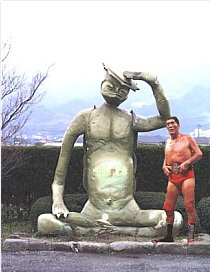 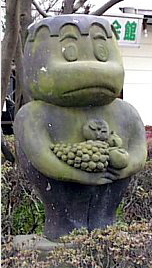
LEFT: Giant Kappa statue near Tanukimachi Station
田主丸駅 Tanushimaru Station, Fukuoka Prefecture
RIGHT: Stone statue near Tanushimaru Station
In modern times, the Kappa often appear as cartoon characters
For more details, see Gabi Greve’s Kappapedia Page.
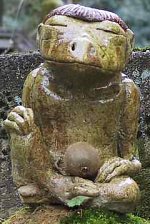 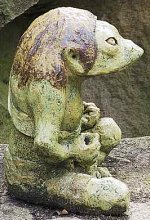
Kappa Statues at Gokoku Shrine, Gifu City
Photos by Reggie Thomson
Below Text Courtesy of JAANUS
Literally river child. A supernatural water-sprite believed to inhabit Japan's lakes and rivers. The name kappa varies from region to region, and includes kawatarou 河太郎, kawako 河伯, and kawaranbe 河ランベ. The appearance of a kappa also varies, but kappa are generally thought to be about the size of a young boy, and covered with green scales. They also have a snout, bobbed hair, and a saucer-like depression on the top of the head that holds water. When this water supply diminishes, the kappa's special powers diminish. Kappa swim well thanks to webbed feet and hands, but can also walk on land. Kappa also can rotate their arm and leg joints fully. Some kappa resemble otters, turtles with beaks, or have wings. Kappa are said to be fond of cucumbers and of sumo 相撲 wrestling. In some regions kappa are thought to be helpful, but generally their reputation is far more malicious. In particular, kappa delight in abducting humans and horses. Kappa are noted for their aversion to metal objects. Illustrations of kappa frequently are included in Edo period anthologies of supernatural tales. Kappa are often depicted in comical paintings (giga 戯画), in paintings accompanying verse (haiga 俳画), and occasionally in ukiyo-e 浮世絵 (woodblock prints; see above photo).
|
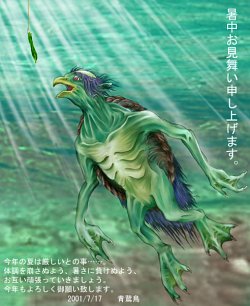
|
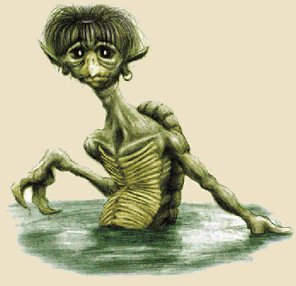
|
|
Kappa, Modern Cartoon Drawing, found at
now defunct web site tenchinohoukai.greatnow.com
Probably a Japanese drawing, but no source was given
|
Kappa illustration by Chip Boles.
See his homepage at chipboles.com
Ilustration from 15 Oct. 2009 edition of metropolis.co.jp
|
|
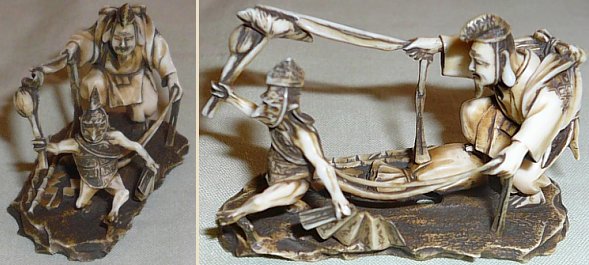
Kappa commanded by Ebisu (god of the ocean)
Ivory okimono (decorative carving), signed Gyokuzan, courtesy Oriental & Fine Art

REFERENCES
- Akutagawa Ryūnosuke 芥川龍之介 (1892-1927). “The Kappa (1927)" & Other Works. Below text courtesy angelfire.com/sk3/asianhorror/a.html. “Supernatural themes surface intermittently throughout his works. While his novella, The Kappa, is more satiric than supernatural, he discusses some of the contemporary psychic research in Japan. In Yabuno Naka, the dead speak through a type of Japanese medium. Other works have tangential references to magic such as Aguni no Kami and Christian mythology in Kirisutohoro Shoin Den, which strangely enough is about the former Saint Christopher. He dabbles in Chinese magic in Toshishun describing how to become a type of Asian magi or seinin. His mother died insane when he was young, and his father gave him up for adoption. Despite his inauspicious beginnings, he had a distinguished academic career at Tokyo University, married and fathered three children. Follower of Natsume Soseki, he produced a fine series of short novels and short stories during his brief lifetime. Cassell's Encyclopedia of World Literature describes his work as "weird and fantastic" and "often symbolical and impressionistic." He committed suicide during a stretch of severe depression. Akutagawa's The Hell Screen is the strongest tale of Japanese horror available in English, using a painter as the conveyor of horror. The Heresy, its sequel, is less successful as horror. Another of his tales, The Spider's Thread, shows the horrors of a Buddhist Hell and the chilling indifference of those in Paradise.”
- Ando Misao 安藤操 and Seino Fumio 清野文男 1993 Kappa no Keifu (The Lineage of the Kappa), Tokyo: Satsuki Shobo 五月書房.
- Foster, Michael Dylan. The Metamorphosis of the Kappa: Transformation of Folklore to Folklorism in Japan. Asian Folklore Studies, Vol. 56, 1998. Also see Pandemonium and Parade: Japanese Monsters and the Culture of Yōkai, by Michael Dylan Foster. English. ISBN-10: 0520253620. Published Nov. 2008.
- Iida Michio, 1993, Kappa ko: sono yugamerareta shotai wo saguru [Thoughts on kappa: Seeking the true form behind the distortion]. Kyoto: Jinbun Shoin.
- Ishida Eiichiro. The Kappa Legend. A Comparative Ethnological Study on the Japanese Water-Spirit Kappa and Its Habit of Trying to Lure Horses into the Water. Published in Folklore Studies, Vol. X, 1950. See the English translation of “The Kappa Legend;” the Japanese-language version is called “Kappa Komabiki Kō” 河童駒引考.
- Ishikawa Jun'ichiro. Shinpan Kappa no Sekai (World of the Kappa, new edition]. Tokyo: Jiji Tsushinsha. 1985. Discusses various versions of shirikodama belief.
- Kasshiyawa Chronicles 甲子夜話, 1821. Purchase book at ebookjapan.jp.
- Ono Katsura. Kappa no Kenkyu (Research on Kappa). Tokyo: San'ichi Shobo, 1994.
- Orikuchi Shinobu. Kappa no Hanashi (A Discussion of Kappa). In Orikuchi Shinobu Zenshu (Collected Writings of Orikuchi Shinobu), Vol. 3, pp. 288-317. Tokyo: Chuo Koronsha. 1955.
- Suiko Junihin no Zu 水虎十二品之図 (Illustrated Guide to 12 Types of Kappa), late Edo period; based on the earlier Suikokōryaku. See high resolution image at the National Diet Library (Tokyo, Japan).
- Suikokōryaku 水虎考略 (Concerning Kappa), attributed to Koga Tōan 古賀侗庵 (1788-1847), first published in 1820. A compendium of kappa information from Japan and China along with sketches of the creature by artist Kurimoto Tanshu 栗本丹洲 (1756-1834). An expanded version was published in 1839. Housed at the Iwase Bunko Library (Aichi Prefecture).
- Takeda Akira 1988 Suijinshinko to Kappa (Water deity belief and the kappa). In OSHIMA 1988, 7-16.
- Yanagida Kunio 柳田國男 (1875 - 1962). Yanagida is the famous anthropologist who did the initial research on the Kappa and other supernatural beings in the Tono region (modern-day Iwate Prefecture). He is considered by some to be the father of Japanese folklore study, and the author of the classic Tono Monogatari 遠野物語 (Legends of Tono), published 1910.
- Yōkai Database 妖怪, International Research Center for Japanese Studies, Kyoto, Japan.
LEARN MORE ABOUT THE KAPPA
- Suijin, Suiten, Mizu no Kamisama (this site). The Kappa river imp is just one of Japan’s many Suijin (literally “water kami”). But don’t confuse the Kappa with the more powerful and more benevolent water deity of Shinto lore known as Mizu no Kamisama (also literally “water deity,” aka Suijin or Suiten).
- GAPPA DOKO. http://www.ishinotent.co.jp/Kappa/kappa-2.html
In many villages, the Kappa is associated with drowning. Such incidents are referred to as “Gappa Doko.” 馬とり淵という伝説があり、村々にはガーッパドコと言ってカッパがよく出没する魔所がある。
Near Nagasaki and the Sagogawa river, locals use the term Gappadoko, plus many other terms, like BUCHI, GAPPA, KIRIDOSHIBUCHI, GAPPADOKO, GATSUPUCHI. They say there is a deep deep water hole, nearly five fathoms deep, where some Kappa live. ブチには名があり、それぞれにガーッパ
がすんでいる。なかでも水死事故があったキリドーシブチを「ガーッパドコ」といい、佐護川のガーッパを
統制する「大将ガーツパ」のすむブチをゴージブチという。ゴージプチはプチの中でも最大、最深(約五
尋)である。
- TONO TOWN, TONO AREA, Iwate Prefecture. The Kappa and Kappa-buchi 河童淵 (river banks/spots where the Kappa hunt their prey) in northern Japan are especially famous. The area itself is surrounded by three mountains (Mt. Hayachine-san, Mt. Rokkoushi-yama, Mt. Ishigami-san), which are known collectively as the Three Mountains of Tono. Tono is well-known for its horse breeding, an activity pursued for centuries in the area. Tono is also a land of old folk tales, especially those about the Kappa that were recorded by Yanagida Kunio in his famous book “Tales of Tono.” Visitors to Tono today can still taste old Japan, for the area still has many thatched farmhouses, fertility shrines, and images of the Kappa. The Sarukaishi River (literally Monkey's Stone River) gently flows through the southern part of Tono city. During its feudal days until the Edo Period, Tono flourished as a market place, lodging town and castle. On December 1, 1954, the eight villages of Aozasa, Ayaori, Kamigo, Matsuzaki, Otomo, Tono, Tsuchibuchi and Tsukimoushi merged to become the city of Tono. Today, the Tono area is home not only to the Kappa, but apparently home as well to the red-faced Tengu and a child-like spirit called the Zashiki Warashi. For more about Tono, please visit www.asia-planet.net/japan/iwate.htm
- Sagojō, Sandy the Water Demon in Journey to the West
Site One (English) || Site Two (J) || Site Three (J)
物語の中では「サゴジョウ」じゃなかったですっけということは、本場中国の「西遊記」に出てくる
「沙悟浄」もやっぱり河童なんでしょうか。そもそも河童というのは、日本独特のものなのでしょうか。
それとも中国あたりから伝わってきたものなんでしょうか。
- KAPPA FESTIVALS
- KAPPA ODORI DANCE, Hita City, Oita Prefecture
A sacred Shinto dance to pray for abundant crops, in which young boys dressed as kappa (water imps) jump and cavort about in time to humorous music. Designated as a Prefectural Intangible Cultural Treasure.
- JOZANKEI HOT SPRINGS & KAPPA FESITVAL
www.asia-planet.net/japan/hokkaido.htm
The symbol of Jozankei Valley is the Kappa, the water sprite. Jozankei (valley) is a hot spring area and spa near Toyohiragawa River in southwest Sapporo (Hokkaido). Called "Sapporo's Back Parlor," the spa is surrounded by mountains, and was discovered by a monk called Jozan, and named after this monk for the efforts he made to develop it. The Kappa is the guardian spirit of the area. Local legend tells of a young boy who fell into a deep pool, where he was taken to the land of the Kappa, and lived happily thereafter (see below Kappa-Buchi Legend). Approximately 23 Kappa stand in various poses around the spa town, including the Great Kappa King. There is also a Kappa Pool, which becomes very lively during the Kappa Festival that takes place in early August.
Kappa-Buchi (Kappa Pool) Legend in Jozankei
According to local folklore, a young man was fishing in a deep pool in Jozankei, but fell in and never surfaced. Months later he appeared in his father's dreams to say he was living happily with the Kappa, and his Kappa wife and child. The pool is named “Kappa-buchi," or kappa pool, in light of this legend. <Courtesy Cathay Pacific>
- Artist Yoshio Yamamoto (his painting appears above)
darumasan.blogspot.com/2009/07/yamashina-paintings.html. Paintings by artist Yoshio Yamamoto, 63 years old (2004). What exactly are Yamashina-e and Otsu-e paintings? During the Edo Period, there were many travelers on the old Tokaido Road between Kyoto and Edo (Tokyo). Each of the 53 postal towns on the way had its own specialty -- mostly some local food. But Yamashina Town, and especially nearby Otsu Town, were famous for funny paintings with religious overtones. Yamashina is now a modern suburb of Kyoto.
- Kappa no Sanpei. Shigeru Mizuki's classic manga from the 1960s, Kappa no Sanpei or Sanpei the Kappa. To read an interview with Shigeru Mizuki, please see monsterama. To read a movie review, see pelleas.net.
- Kappa Photos and Information
Kappa Photo Tour (this site) || Pinktentacle.com || Kirainet.com || Monsterama.blogspot.com
Also see Gabi Greve’s Kappa - The Kappapedia.

Last Update = Aug. 22, 2013 (Added more photos and references)
Last Update = Nov. 13, 2011 (Added more references, new top photo)
Last Update = Feb. 2011 (Added more photos & reference notes)
See the Kappa Photo Tour page for even more photos.
|
|